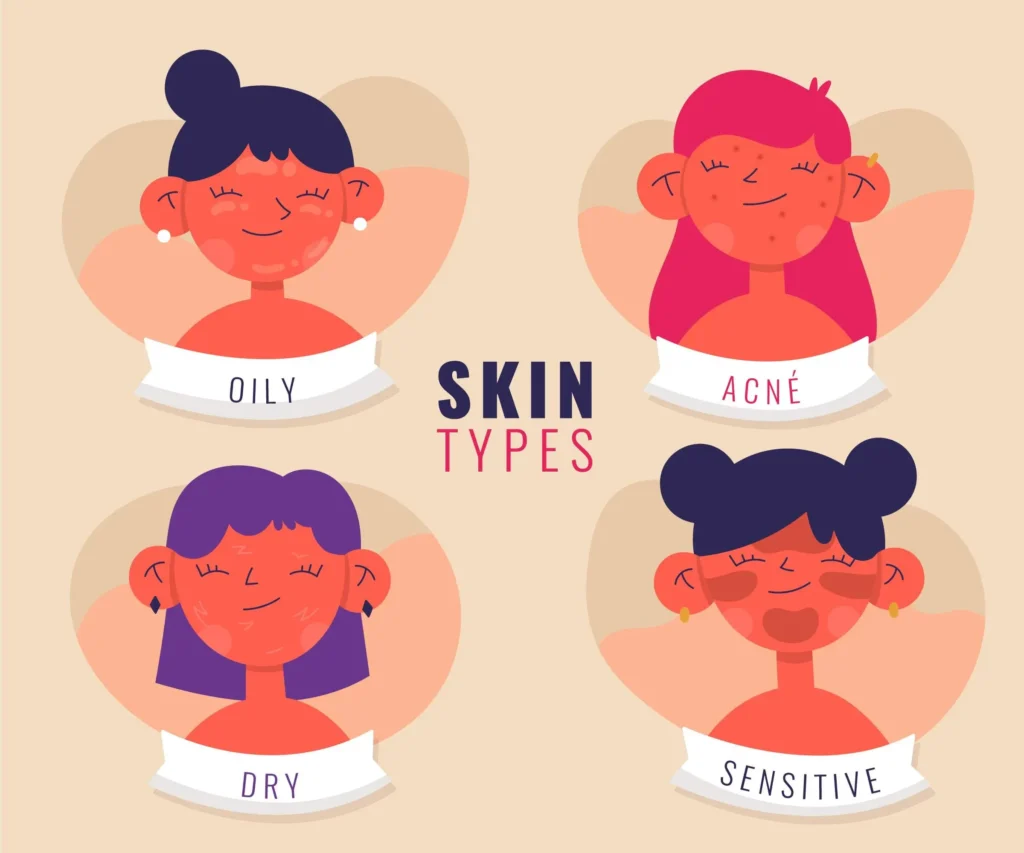Understanding your skin type is the first step to achieving a healthy, radiant complexion. And when it comes to skincare, finding the perfect combination of sunscreen and moisturizer combos for every skin type can make a world of difference. Let’s dive into the specifics of sunscreen and moisturizer matchups for different skin types.
Understanding Your Skin Type For Sunscreen and Moisturizer Combos
Before we delve into product recommendations, it’s crucial to accurately identify your skin type.
- Oily Skin: Characterized by a shiny T-zone (forehead, nose, and chin), enlarged pores, and frequent breakouts.
- Dry Skin: Often feels tight and flaky, with a rough texture and visible fine lines.
- Combination Skin: A mix of oily and dry areas, typically an oily T-zone with dry cheeks.
- Sensitive Skin: Reacts easily to products with redness, itching, or burning.
- Acne-Prone Skin: Characterized by breakouts, blackheads, and whiteheads.
1. Sunscreen and Moisturizer for Oily Skin
Sunscreen
Opt for lightweight, oil-free, and non-comedogenic formulas with a matte finish. Look for mineral-based sunscreens with zinc oxide or titanium dioxide as active ingredients. These are less likely to clog pores.
- Recommended ingredients: Hyaluronic acid, niacinamide
- Product examples:
La Roche-Posay Anthelios Ultra-Light Sunscreen SPF 50
EltaMD UV Clear Broad-Spectrum SPF 46
Moisturizer
Choose oil-free, gel-based moisturizers with hydrating ingredients like hyaluronic acid. Look for products labeled “non-comedogenic” or “oil-free.”
- Recommended ingredients: Hyaluronic acid, niacinamide, salicylic acid
- Product examples:
CeraVe Oil-Free Moisturizer
Clinique Dramatically Different Moisturizing Gel
2. Sunscreen and Moisturizer for Dry Skin
Dry skin needs deep hydration and protection from the sun’s harmful rays.
Sunscreen
Look for moisturizing sunscreens with a creamy or lotion texture. Ingredients like hyaluronic acid and glycerin can provide extra hydration. Opt for broad-spectrum sunscreens with SPF 30 or higher.
- Recommended ingredients: Hyaluronic acid, glycerin, ceramides
- Product examples:
Cetaphil Moisturizing Lotion with SPF 50
Eucerin Daily Hydration Broad Spectrum SPF 30
Moisturizer
Choose rich, creamy moisturizers with emollients like shea butter, cocoa butter, or ceramides to lock in moisture. Look for products labeled “hydrating” or “intensive moisturizing.”
- Recommended ingredients: Shea butter, cocoa butter, ceramides, hyaluronic acid
- Product examples:
Vanicream Moisturizing Cream
Aveeno Daily Moisturizing Lotion
3. Sunscreen and Moisturizer for Combination Skin
Balancing the oily and dry areas of your skin requires a tailored approach.
Sunscreen
A lightweight, oil-free sunscreen for the oily T-zone and a moisturizing sunscreen for the dry areas can be a good combination. Look for broad-spectrum formulas with SPF 30 or higher.
- Recommended ingredients: Hyaluronic acid, niacinamide, glycerin
- Product examples:
Neutrogena Hydro Boost Water Gel Lotion SPF 50
Garnier SkinActive Clearly Brighter Daily Moisturizer SPF 30
Moisturizer
Use a gel-based moisturizer for the oily areas and a cream-based moisturizer for the dry areas. Alternatively, consider a lightweight, oil-free moisturizer for overall hydration.
- Recommended ingredients: Hyaluronic acid, niacinamide, glycerin
- Product examples:
Olay Regenerist Whip Moisturizer
Cerave Moisturizing Cream
4. Sunscreen and Moisturizer for Sensitive Skin
Sensitive skin demands gentle, hypoallergenic products.
Sunscreen
Opt for mineral-based sunscreens with zinc oxide or titanium dioxide as they are less likely to cause irritation. Look for fragrance-free, hypoallergenic formulas.
- Recommended ingredients: Zinc oxide, titanium dioxide, hyaluronic acid
- Product examples:
La Roche-Posay Anthelios Mineral Ultra-Light Sunscreen SPF 50
Aveeno Protect + Hydrate Sensitive Skin Sunscreen Lotion SPF 50
Moisturizer
Choose a gentle, fragrance-free, and hypoallergenic moisturizer with soothing ingredients like aloe vera or chamomile. Look for products labeled “sensitive skin.”
- Recommended ingredients: Aloe vera, chamomile, hyaluronic acid
- Product examples:
Cetaphil Gentle Skin Cleanser
Aveeno Calm + Restore Moisturizing Cream
5. Sunscreen and Moisturizer for Acne-Prone Skin
Acne-prone skin requires special care to prevent breakouts and protect from sun damage.
Sunscreen
Opt for lightweight, oil-free, and non-comedogenic formulas with a matte finish. Look for mineral-based sunscreens with zinc oxide or titanium dioxide as active ingredients. These are less likely to clog pores.
- Recommended ingredients: Hyaluronic acid, niacinamide, salicylic acid
- Product examples:
La Roche-Posay Anthelios Ultra-Light Sunscreen SPF 50
EltaMD UV Clear Broad-Spectrum SPF 46
Moisturizer
Choose oil-free, gel-based moisturizers with hydrating ingredients like hyaluronic acid and salicylic acid to help unclog pores and prevent breakouts. Look for products labeled “non-comedogenic” or “oil-free.”
- Recommended ingredients: Hyaluronic acid, niacinamide, salicylic acid, benzoyl peroxide (for spot treatment)
- Product examples:
CeraVe Oil-Free Moisturizer
Clinique Dramatically Different Moisturizing Gel
Additional Tips for Sunscreen and Moisturizer Selection
- Patch Test: Before using a new product, especially if you have sensitive skin, do a patch test on a small area of your skin to check for any adverse reactions.
- Broad-Spectrum Protection: Always choose a sunscreen that offers broad-spectrum protection against both UVA and UVB rays.
- SPF Level: Opt for a sunscreen with an SPF of 30 or higher.
- Re-application: Reapply sunscreen every two hours, or more frequently if you’re swimming or sweating.
- Consistency: Consistency is key. Using sunscreen and moisturizer daily is essential for protecting your skin and maintaining its health.
By understanding your skin type and choosing the right sunscreen and moisturizer combination, you can achieve a healthier, more radiant complexion.





